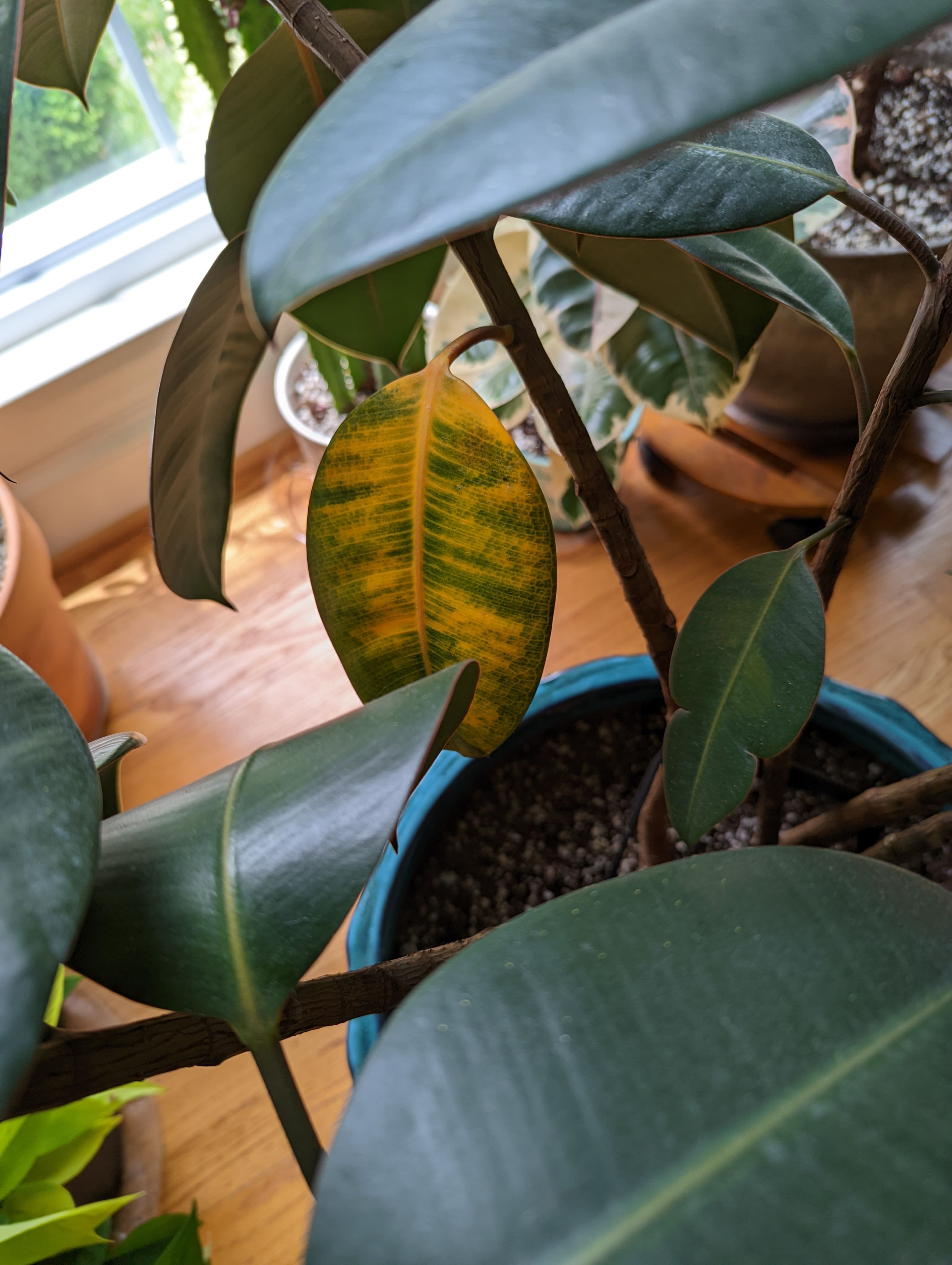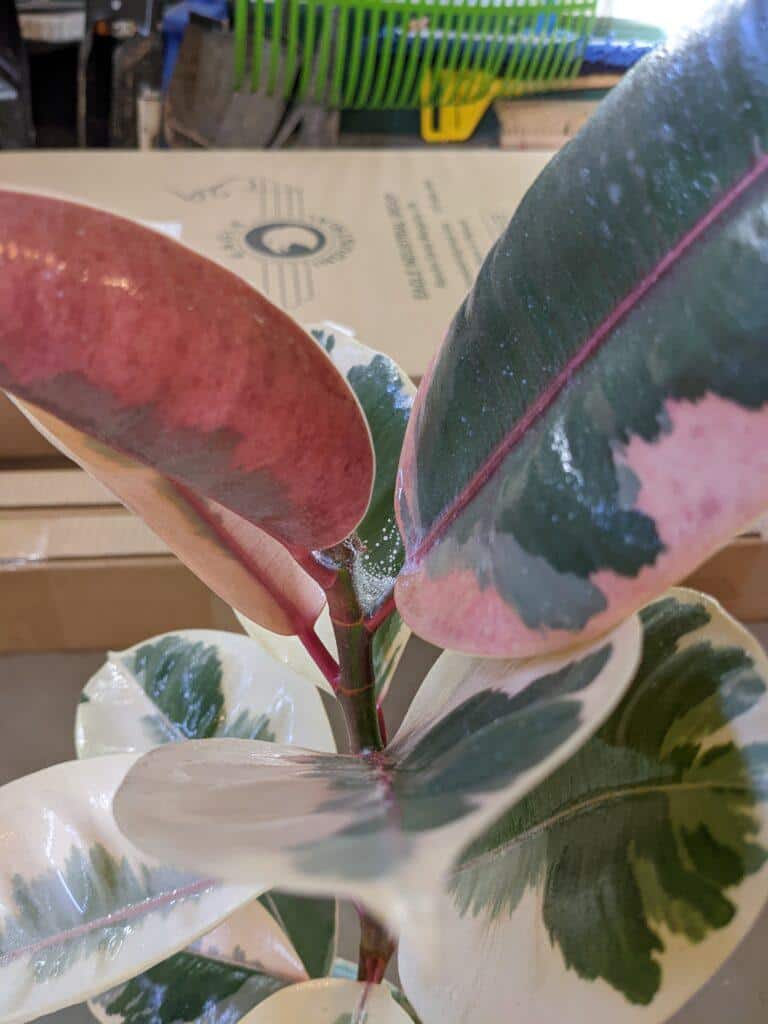Occasionally, especially in the winter, my big Burgundy Rubber Plant will lose a leaf or two. Leaf drop can be no big deal, or it may be your plant telling you that you need to intervene. If you’re concerned about your Rubber Plant losing leaves, follow this post as I cover some scenarios about leaf loss and how to address them if need be.
Why is My Rubber Plant Losing Leaves?
Water Issues Can Cause Leaf Drop
Both underwatering and over-watering can cause Rubber Plants to lose leaves. I find the most reliable way to tell if there are water issues is to use a soil moisture meter. Something cheap and simple like this soil moisture meter will do the trick. If you don’t have a moisture meter, you can also use your finger to test the soil moisture. You don’t want to let the soil completely dry out, but you should allow the top inch or two of soil to dry in between waterings.
I err on the side of keeping my houseplants slightly dry, mostly to combat every plant lover’s nemesis, fungus gnats. Dry soil in some plants can be really obvious because they droop, but Rubber Plants have hardier leaves and stems so they don’t do the telltale droop, at least not quickly. If you are underwatering, typically the leaves that turn yellow and drop first are the oldest ones closest to the base of a stem. These are the older leaves and tend to be more susceptible to drying out. You can see an example in the photo below. Once a leaf is yellowing, that means it’s going to drop.

Conversely, if your soil feels moist it could be overwatered. The leaves may start to turn yellow or get brown spots on them. Overwatered leaf damage will be more disbursed and not concentrated on leaves at the base of the stems. Overwatering will cause both leaf and root damage and eventual leaf drop.
How to Fix Water Issues
If you are underwatering you’ll need to a larger quantity of water or to water it more often. I want to say for clarity though that just because a lower leaf turns yellow, does not automatically mean your plant is underwatered. In fact, it can be completely normal for a single older leaf to eventually yellow and fall off your Rubber Plant. If you have multiple leaves dropping, then you be more concerned.
If you do think you are underwatering, don’t go too far in the other direction. Any yellow leaf you find will eventually drop. You can let them fall off on their own, or pull them off if you want to. When you do start watering more, make sure that the water doesn’t just run through your plant. That can happen if it was previously underwatered because the soil has dried out too much. If that happens, you may need to water from the bottom, which just means sticking your plant pot in a bowl or the sink with water and the soil and roots soak up water from the base of the plant.
If you have overwatered, the intervention is more complicated. The first thing you want to do is carefully remove your Rubber Plant from its pot. Doing so will let the root ball and soil dry out more quickly. Overwatered roots are very tender and vulnerable, so you must be sure to be careful and clean. Once the root ball has dried enough to handle, inspect the roots for rot. I have a post all about Rubber Plant roots. Healthy roots are white or light brown and firm, rotten roots will be dark brown and feel mushy. If you find rotten roots, you need to cut them away with something clean and sharp. Then you can repot your Rubber Plant in new soil and hope for the best.
Fertilizing Issues Can Cause Leaf Drop
Nutrients are the same as water where you can both over- and under-fertilize. Leaf drop is generally a sign of under-fertilization. You’ll see widespread leaf discoloration well before the leaves drop though. Plants that have been over-fertilized are more likely to exhibit slow growth and maybe wilting. Typical houseplant fertilizers have a balanced ratio of nitrogen, phosphorous, and potassium, or n-p-k, which you see on the label of the plant fertilizer. Leaf drop may be a symptom of a lack of nitrogen or potassium. Nitrogen helps promote healthy foliage growth and potassium helps promote overall plant health.
Fertilization issues may affect the lowest leaves first but you’ll often see signs in a lot of leaves. Other signs that you have a fertilization issue can be slow growth. Rubber Plants aren’t the fastest growers anyway, so it can be difficult to tell if your plant is growing slowly or normally. I use soil rapitest which allows you to test for ph and each nutrient individually. These tests are the best way to be totally sure about your plant’s nutrient deficiency or abundance. If you have a lot of plants, it’s a good tool to keep around.
How to Fix Fertilization Issues
An overfertilized Rubber Plant can be fixed by flushing the soil. To do this you’re really just heavily watering so that the water is running through the soil and out of the pot. You may even want to remove the plant from its pot. That will let the water flush freely and also let the soil dry better because you don’t want to end up overwatering either.
To fix an under-fertilized plant you just need to fertilize it. Water-soluble or liquid fertilizers work best for quicker absorption. If you don’t opt for the soil rapitest that I mentioned earlier, then you’re best off sticking with a balanced fertilizer that has the same number in the n-p-k ratio. However, if you know for sure you have either nitrogen or potassium deficiency, then you can find fertilizers that have higher ratios of the nutrient you need. Be sure to follow the instructions on the fertilizing product. Some fertilizers require dilution or that you water the plant beforehand.
Pests Can Cause Leaf Drop
Unfortunately, a wide variety of pests can attack indoor plants. The big ones that attack foliage, causing your Rubber Plant to lose leaves, are aphids, scale/mealybugs, spider mites, and thrips. They all feed on the leaves. Pest damage on leaves will typically show up as collections of tiny spot yellow or brown marks where the pests have attacked. If you think you might have pests, do a close visual inspection of your plant asap. Use a flashlight to help you see contrast and shadows. Pay close attention to the underside of the leaves and where new leaves are growing, that’s where they hang out the most.

How to Fix Pest Issues
If you have pests, it is very important that you move the infested plant away from other healthy plants immediately. Pests are experts at traveling to seek and destroy new plants! Next, you’ll need a multipronged approach to address the pests. Remove as many pests as possible first. A strong spray can remove most pests. You can do so in the shower or outside with a hose. Scale and mealybugs require manual removal because they have an armor-like shell.
Next use an insecticide. There are organic versions like neem oil that do well. I have personally used neem oil on spider mites that had infested one of my Rubber Plants successfully. Nonorganic insecticidal soap also works. The most critical thing to do is to repeat removal and insecticide application until you do not see any pests for over a week. The reason is that pests have short lifecycles, just because you don’t see them one day doesn’t mean you’ll be pest-free tomorrow.
Hopefully, this helps explain some causes of Rubber Plants losing leaves, and now you can begin your journey to fix it. Have any questions? Post them in the Comments section below.

I'm a long time plant lover on the quest to happily coexist with as many plants as I can. Let's grow!
